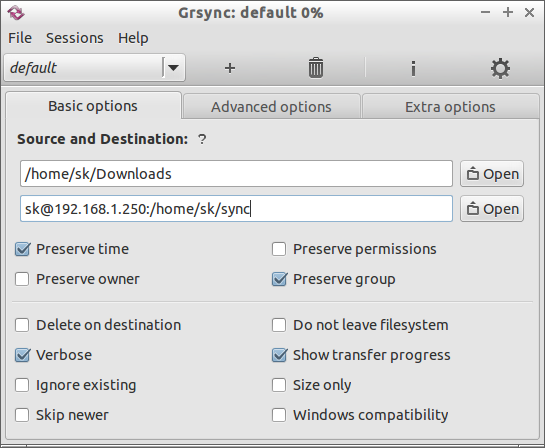
- #Grsync vs arrsync mac os x#
- #Grsync vs arrsync upgrade#
- #Grsync vs arrsync full#
- #Grsync vs arrsync windows#
com / alloy / terminal - notifier * ) - Define network volume set strUser to "Some User" set strServer to "" set strVolume to "Scratch" - Define network volume set strNetwork to "/Volumes" - Define local volume set strLocal to "/Volumes/Volatile/Local Cached" - Define data source set strData to "Testing" - No user defines below - global notifyApp global notifyGroup global notifyTitle - terminal-notify defines set pathApp to "/Users/Adi/Scripts" set pathBundle to "/terminal-notifier. terminal - notifier can be found at : https : // github.
#Grsync vs arrsync mac os x#
It also relies on the terminal - notifier command - line tool to send Mac OS X User Notifications. (* This script sync data up or down a network volume up = send data from local volume to network volume down = send data from network volume to local volume This script requires the Mountain Lion. This allows for detailed forensics on the rsync process if desired. Once completed, the very detailed log file is deleted and placed into the Trash. It also captures the rsync command output and offers to display it at the completion of the operation. The script will prompt for instructions, such as to whether to upload or download. Here is the AppleScript I cooked up to keep two filesystem locations in sync using rsync.
#Grsync vs arrsync upgrade#
However, since I just braved the upgrade to Mountain Lion, leaving the beloved Snow Leopard in the dust, I decided to play with some AppleScript. Until now I have been using a shell script to do the various rsync tasks I required. This especially true if the vast bulk of the data does not change. It is the perfect tool to keep large amounts of data synchronized across volumes. Then the new hard link should present a smaller size then the old hard link.I like rsync… a lot. When I delete data in that file, it becomes smaller. So a hard link presents the same size as the file it points to. Yes, I found the answer to the first question: there’s a file excluded in the settings, and its size is 2.3 Gb, which makes up for the difference. Thanx sanmig, I only read your reply just now. Only the total size of two (or more) incremental backups will be smaller than the sum of both (or all), depending on the difference in the data files.īut when you create a new backup folder (in the Settings) and take a backup the source file will be copied again into the new back up folder, requiring the same space there, too. Each hard link is a perfect pointer to one and the same file, not ‘just a link’ … think of something more bidirectionally, similar to a mirror. Below are the exact words on how it works from the tool itself. unixlinux/) the incremental (hard) link presents the same file size as the first file to the OS, it is the same file. Yes, the backups are incremental, but because of using Rsync (hard links, see. From deciding the type of shell that should be used to files that should be excluded in a transfer, rsync gives you the power to shape the transfer specifications. Rsync has many options that can help you define the connections you make. Otherwise original and backup must have the same size! Rsync is a Linux-based tool that can be used to sync files between remote and local servers. my foxclone test images require root permission to access - unfortunately Nemo offers “Copy” but fails to do it as standard user …). In my case, when using B.I.T as normal user, there are warnings and files missing because of deficient permissions (e.g. I can not explain but suspect not all files were backed up: Compare them using Nemo and check the log (menu "View"). The first is the difference between 5.5 and 3.2 GB. Since Back in Time snapshots are incremental, I would expect the first snapshot to be larger than the second? Grsync can be use to synchronize a music collection with removable.
#Grsync vs arrsync windows#
Its a cross platform tool, works on Linux, Windows OS and Mac OS. Grsync is a graphical user interface front-end for the rsync tool. So if you restore files without Back in Time, permissions could get lost. Today, I will introduce some graphical front-end tools called Grsync and Gadmin-rsync which will help to ease the usage of rsync tool. If the backup drive does not support permissions Back in Time will restore permissions from fileinfo.bz2. They can be browsed with a normal file-browser or in Terminal which makes it possible to restore files even without Back in Time.įiles ownership, group and permissions are stored in a separate compressed plain text file ( fileinfo.bz2). Same here, original files are rw-, snapshots are r-, to protect them I guess.

#Grsync vs arrsync full#
I think the read only is an attempt to protect the backup’s integrity, as I haven’t seen data files with rw in the backup?Īlso all attributes are stored in an extra file so one could use a NTFS destination for the backup, with full rsync it requires the ext format. rw what was -r-, it would be useless otherwise.

As you wrote, at restore all the permissions are restored, e.g.


 0 kommentar(er)
0 kommentar(er)
